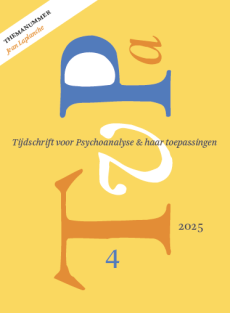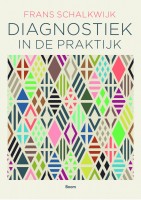Enkele betekenissen van de bank
Samenvatting
Wij hebben resoluut het denkbeeld afgewezen om van de patiënt die hulp zoekt en zich aan ons toevertrouwt, ons eigendom te maken, zijn lot voor hem vorm te geven, hem onze idealen op te dringen en, met de hoogmoed van de Schepper, hem naar ons evenbeeld te vormen waaraan wij dan welbehagen moeten vinden . (Freud 1919, p. 185)
Literatuur
- Aruffo, R.N. (1995). The couch: reflections from an interactional view of analysis. Psychoanalytic Inquiry, 15, 369-385.
- Balint, M. (1968). The basic fault; therapeutic aspects of regression. Londen: Tavistock Publications.
- Berkouwer, A.Y. (2004). Handboek: de psychoanalytische setting Anatomie van een plek. Amsterdam: Boom.
- Bögels, G. (2006). De bank voor mij. Tijdschrift voor Psychoanalyse, 12,129- 135.
- Freud, S. (1913). Verdere adviezen over de psychoanalytische techniek I: Over het inleiden van de behandeling. Sigmund Freud Nederlandse Editie: Klinische Beschouwingen 4 (p. 105-128). Meppel / Amsterdam: Boom.
- Freud, S. (1919 [1918]). Wegen der psychoanalytische therapie. Sigmund Freud Nederlandse Editie: Klinische Beschouwingen 4 (p. 179-189). Meppel / Amsterdam: Boom.
- Gill, M.M. (1994). Psychoanalysis in transition A personal view. Hillsdale nj / Londen: The Analytic Press.
- Greenacre, Ph. (1954). The role of transference Practical considerations in relation to psychoanalytic therapy. O.a. in Ph. Greenacre, Emotional Growth, Volume II (p. 627-640). New York: International Universities Press, 1971.
- Hunter, V. (1994). Psychoanalysts talk. New York / Londen: The Guilford Press.
- Isakower, A. (1938). A contribution to the psychopathology of phenomena associated with falling asleep. International Journal of Psycho-Analysis, 19, 331-345.
- Istanbul: de stad en de sultan (2006). Catalogus bij de tentoonstelling in de Nieuwe Kerk. Amsterdam: Stichting Winkel Nieuwe Kerk.
- Jacobs, T.J. (1991). The use of the self Countertransference and communication in the analytic situation. Madison CN: International Universities Press.
- Kardiner, A. (1977). My analysis with Freud Reminiscences. New York: W.W. Norton & Comp. Inc.
- Little, M.I. (1990). Psychotic anxieties and containment A personal record of an analysis with Winnicott. Northvale NJ/ Londen: Jason Aronson.
- Mettrop, P.J.G. (1987). Horen, zien en beleven Visies op vis-à-vis versus psychoanalyse. Inzicht, 16-17-18, 9-20.
- Meyer, J. (2007). Analysis and re-analysis. Plenary address, Winter meeting American Psychoanalytic Association, New York.
- Mooij, A.W.M. (1982). Psychoanalyse en regels Werkwijze en grondslagen van de psychoanalyse. Meppel / Amsterdam: Boom.
- Mooij, A.W.M. (2002). Psychoanalytisch gedachtegoed Een modern perspectief. Amsterdam: Boom.
- Moraitis, G. (1995). The couch as a protective shield for the analyst. Psychoanalytic Inquiry, 15, 406-412.
- Reich, W. (1933). Characteranalyse. Keulen / Berlijn: Kiepenheuer & Witsch, 1970.
- Rosenbaum, S. (1967). Symbolic meaning and theoretical significance of the analytic couch. Science and Psychoanalysis, 11, 182-201.
- Ross, J.M. (1999). Once more onto the couch. Journal of the American Psychoanalytic Association, 47, 91-111.
- Stein, M. (1965). States of consciousness in the analytic situation. In: M. Schur (red.), Drives, affects, behavior (p. 60-86). New York: International Universities Press.
- Steiner, J. (2006). Seeing and being seen: narcissistic pride and narcissistic humiliation, International Journal of Psychoanalysis, 87, 939-951.
- Stern, H.R. (1978). The couch Its use and meaning in psychotherapy. New York / Londen: Human Sciences Press.
- Stoller, R.J. (1979). Sexual excitement Dynamics of erotic life. New York: Pantheon Books.
- Stufkens, A. (2003). Trust and mistrust as basic factors in psychoanalytic treatment Theoretical and clinical considerations. In: Working alliance Basic trust and mistrust. Papers of the 10th hgp-piee Summerschool. Ukraine: Kharkov.
- Tessman, L.H. (2003). The analysts analyst within. Hillsdale NJ/Londen: The Analytic Press.
- Winnicott, D.W. (1954). Metapsychological and clinical aspects of regression within the psycho-analytical set-up. O.a. in D.W. Winnicott, Through paediatrics to psycho-analysis (p. 278-294). Londen: The Hogarth Press and the Institute of Psycho-analysis, 1977.
- Zubek, J.P. & MacNeill, M. (1967). Perceptual deprivation phenomena: role of the recumbent position. Journal of Abnormal Psychology, 72, 147-150.
 © 2009-2025 Uitgeverij Boom Amsterdam
© 2009-2025 Uitgeverij Boom Amsterdam
ISSN 1382-516x
De artikelen uit de (online)tijdschriften van Uitgeverij Boom zijn auteursrechtelijk beschermd. U kunt er natuurlijk uit citeren (voorzien van een bronvermelding) maar voor reproductie in welke vorm dan ook moet toestemming aan de uitgever worden gevraagd:
Behoudens de in of krachtens de Auteurswet van 1912 gestelde uitzonderingen mag niets uit deze uitgave worden verveelvoudigd, opgeslagen in een geautomatiseerd gegevensbestand, of openbaar gemaakt, in enige vorm of op enige wijze, hetzij elektronisch, mechanisch door fotokopieën, opnamen of enig andere manier, zonder voorafgaande schriftelijke toestemming van de uitgever.
Voor zover het maken van kopieën uit deze uitgave is toegestaan op grond van artikelen 16h t/m 16m Auteurswet 1912 jo. Besluit van 27 november 2002, Stb 575, dient men de daarvoor wettelijk verschuldigde vergoeding te voldoen aan de Stichting Reprorecht te Hoofddorp (postbus 3060, 2130 KB, www.reprorecht.nl) of contact op te nemen met de uitgever voor het treffen van een rechtstreekse regeling in de zin van art. 16l, vijfde lid, Auteurswet 1912.
Voor het overnemen van gedeelte(n) uit deze uitgave in bloemlezingen, readers en andere compilatiewerken (artikel 16, Auteurswet 1912) kan men zich wenden tot de Stichting PRO (Stichting Publicatie- en Reproductierechten, postbus 3060, 2130 KB Hoofddorp, www.cedar.nl/pro).
No part of this book may be reproduced in any way whatsoever without the written permission of the publisher.
Nieuwsbrief Boom Psychologie
Meld u nu aan en ontvang maandelijks de Boom Psychologie nieuwsbrief met aantrekkelijke aanbiedingen en de nieuwe uitgaven.
Aanmelden


